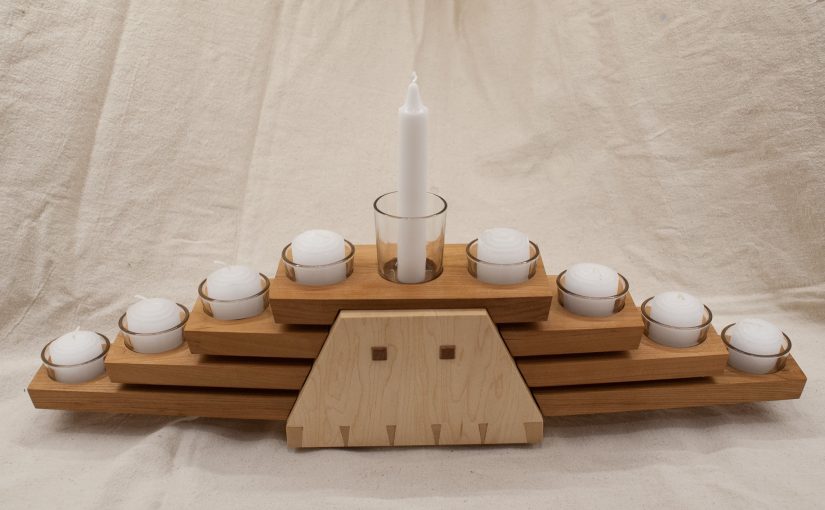I have designed and built a Hanukkah Menorah. The materials are cherry for the bulk of it and maple for the base. The design goal was to marry the traditional and the modern forms. I wanted the design to look contemporary and fresh, for something as traditional as a menorah.
I used glass cups from cheap candles purchased at a dollar store to house 1.5″ candles for the eight main candles; the service candle cup accepts a 1″ to 1.25″ diameter candle (the above image shows a 3/4″ candle, which is too small, because I did not yet have a 1″ candle on hand when I photographed it). The low 1.5″ candles are readily available and inexpensive, but the 1″ candles are harder to find.

The project was built with mostly hand tools, the base has hand cut dovetails at the bottom and two square pegs with ends left proud of the surface for aesthetic reasons, à la Greene and Greene, except that these are not plugs, but long pegs that go all the way through the two walls of the base. The pegs are made of cherry.

Cross-grain design issues have been accommodated by not gluing the sides of the base to the stack of “leaf” members – the stack is free to expand and contract vertically and laterally, and the holes in the stack for the square pegs have been over-sized to allow for wood movement. There is about 1/16″ clearance all around the base (which is inset into the stack of leaf members) to allow for wood movement. The stack is glued to the bottom of the base only in a small area in the middle, so that that cross-grain glue joint would not fail from the seasonal wood movement.

The base has 1/4″ tall Polylastomer® feet to stand on. I was a bit worried that the menorah could come out a bit tippy because the area between the feet is small relative to the size of the whole object, but this proved to be not an issue, it is stands very solidly. This is probably because the bulk of the weight is located above the base.
The leaf members are gradually tapered from the base towards the ends. The amount of taper differs – lower members taper by a greater amount than the top ones.

The glass cups are inset and epoxied into recesses that were drilled out with a Forstner bit on a drill press (one of the few operations performed with a powered tool). The Forstner bit leaves a depression in the middle of the recess, which looks unnecessary when there are no candles in the glass cups, but is not visible when the candles are used. Ideally, I would like to use brass cups instead of glass, but I don’t own a metal lathe to make them. If I were making the brass cups, then I would design the cup for the service candle to accept a 3/4″ candle, which are more readily available in the stores. I did not find a glass cup that would work with a 3/4″ candle.

The finish is three layers of semi-gloss wipe-on Poly, with light sanding in between.
